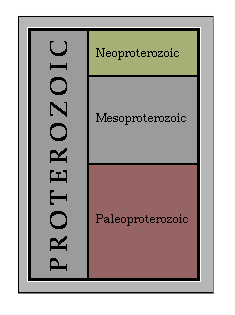







 The period of Earth's history that began 2.5 billion years ago and
ended 544 million years ago is known as the Proterozoic; it is divided up,
rather arbitrarily, into the Paleoproterozoic (2.5 to 1.6 billion years
ago), Mesoproterozoic (1.6 billion to 900 million years ago) and
Neoproterozoic (900 to 543 million years ago). Near the beginning of the
Proterozoic, stable continents first appeared and began to accrete, a long
process taking about a billion years.
The period of Earth's history that began 2.5 billion years ago and
ended 544 million years ago is known as the Proterozoic; it is divided up,
rather arbitrarily, into the Paleoproterozoic (2.5 to 1.6 billion years
ago), Mesoproterozoic (1.6 billion to 900 million years ago) and
Neoproterozoic (900 to 543 million years ago). Near the beginning of the
Proterozoic, stable continents first appeared and began to accrete, a long
process taking about a billion years.
Where was this oxygen coming from? Cyanobacteria, photosynthetic organisms that produce oxygen as a byproduct, had first appeared 3.5 billion years ago, but became common and widespread in the Proterozoic. Their photosynthetic activity was primarily responsible for the rise in atmospheric oxygen.
Graham Shields, at the Institute of Geology in Zurich, Switzerland, has written this on-line research paper on the influence of changing oxygen levels on the early evolution of metazoans.
Read about the Llano uplift in central Texas, which is of Proterozoic age.

Holland, H.D. 1994. Early Proterozoic atmospheric change. Pp. 237-244. In: Bengtson, S. (ed.) Early Life on Earth. Columbia University Press, New York.

